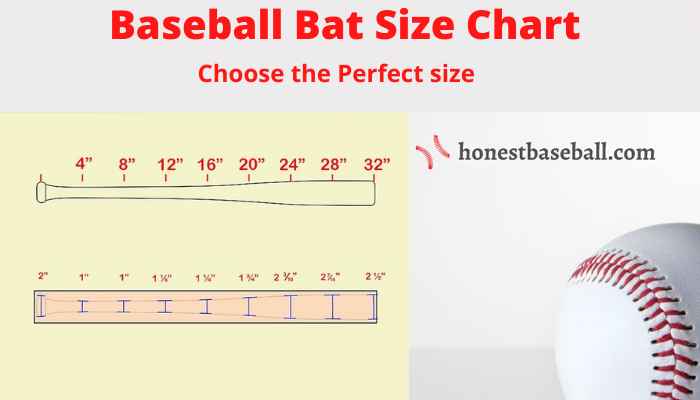Nowadays, it’s something challenging to select the right bat size for baseball. Whether it’s for you or your kids. Also, the baseball bats or softball bats. And for both cases, there is a bat size chart to help you.
Selecting the properly sized bats depends on many things. They include length, the weight of the bat, height, and weight of the batter, age group, leagues, governing body resolutions, and so on.
Also, there are a bunch of baseball bat manufacturers on the market as well.
Seems confusing, and overwhelming to determine the right bat size? Ok, if so, keep your hypertension away, and let us help you.
Our baseball bat experts made some bat size charts after extensive research. To make the chart, there are many relevant things to explore as well.
So, I will be talking about things to clarify the confusion about the right size charts and others. I hope this will be a great solution to picking the perfect bat with the right bat size.
Bat Anatomy
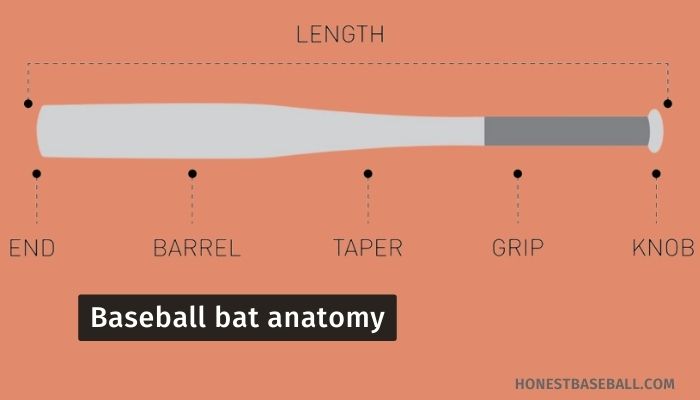
Before going into the topic, let’s first talk about baseball bat anatomy. The baseball bats consist of different parts that all collaborate with each other.
Whether a softball bat, a baseball bat, alloy bats, wooden bats, or composite bats, all of them have the same parts. They are as follows.
Handle: The handle is the part that batters hold. All power from the batter’s hands to the barrel goes through the handle. Ultimately, the handle connects the batter to the ball to hit in the end.
Knob: The knob is the part that helps to keep the hands stable. This also keeps your hands in place with the grip when you hold the grip. As a result, your hands do not slip down the handle.
Grip: The grip is the rubber object that covers the handle so that you get proper hold ability on the bat’s handle. The grip also provides comfort as they are made of soft materials.
Taper: After the handle to the main barrel part, the bat gets tapered. The part that connected from the skinny handle to the wider part of the barrel’s end is the taper of the bat. The taper helps to generate the power dynamically with the bat.
Barrel: The barrels are the thickest part of the bat. Basically, the barrel is the part that contacts the balls. So, all power that comes to the ball is from the barrel directly.
End Cap/ End: The end cap is the last part of the bat that is combined with the barrel. End caps balance the barrel’s swing weight as well as help control the bat. It helps to add and eliminate the weight of the bat, and bat speed.
Bat Size Charts: Considering Different Attributes
Bat Size Chart by Baseball Bat Experts: Recommended Bat’s Length by Players Weight and Height (DicksSportsgoods)
Selecting the baseball bat size depends on several factors. Experts in the industry have made many baseball charts depending on the attributes and entities.
Among them, Louisville Slugger, DicksSportingGoods, and other experts have their own size charts. Though they have very minor differences, all are efficient.
According to DickSportsGoods, the baseball bat size chart is as follows based on the batter’s weight and height.
| Determining Bat Length by Weight and Height of the Players |
| Weight\Height | 3’-3’4” | 3’5”-3’8’ | 3’9”-4’ | 4’1”-4’4” | 4’5”-4’8” | 4’9”-5’ | 5’1”-5’4” | 5’5”-5’8’ | 5’9”-6’ | 6’+ |
| Under 60 lbs | 26” | 27” | 28’ | 29” | 29” | |||||
| 61-70 lbs | 27” | 27” | 28” | 29” | 30” | 30” | ||||
| 71-80 lbs | 28’ | 28” | 29” | 30” | 30” | 31” | ||||
| 81- 90 lbs | 28” | 29” | 29” | 30” | 30” | 31” | 30’ | |||
| 91- 100 lbs | 28” | 29” | 30” | 30” | 31” | 31” | 32” | |||
| 101-110 lbs | 29” | 29” | 30” | 30” | 31” | 31” | 32’ | |||
| 111-120 lbs | 29” | 29” | 30” | 30” | 31” | 31” | 32” | |||
| 121- 130 lbs | 29” | 29” | 30” | 30” | 31” | 32” | 33” | 33” | ||
| 131- 140 lbs | 29” | 30” | 30” | 31” | 31” | 32’ | 33” | 33” | ||
| 141 to 150 lbs | 30” | 30” | 31” | 31” | 32” | 33” | 33” | |||
| 151-160 lbs | 30” | 31” | 31” | 32” | 32” | 33” | 33” | |||
| 161- 170 lbs | 31” | 31” | 32’ | 33” | 33” | 33” | 34” | |||
| 171-180 lbs | 32” | 33” | 33” | 34” | 34” | |||||
| 181+ lbs | 33” | 33” | 34” | 34” |
Table of Bat’s Drop Weight and Bat Length by Age Group and Leagues: Recommended by Louisville Slugger
According to the Louisville Slugger, one of the bleeding baseball bat manufacturers under the Wilson Baseball Goods Manufacturer the drop weight by associations, and the length by age are as follows.
| Determining Bat Drop Weight by Leagues |
| Sporting Association | Age Group | Bat’s Drop weight |
| BBCOR | High School (13-15) | -3 |
| BBCOR | College (16 and above) | -3 |
| USA & USSSA | 13-14 | -5 |
| USA & USSSA | 12-13 | -8 |
| USA & USSSA | 10-12 | -10 |
| USA & USSSA | 10 & under | -11 and above |
The Most common and Popular Length of Baseball Bats by Age Group
| Age Group (Years) | 5-7 | 8-9 | 10 | 11-12 | 13-14 | 15-16+ |
| Bat’s Length | 24”-26” | 26”-28” | 28”-29” | 30”-31” | 31”-32” | 32”-33” |
| Drop Weight | -13.5 to -12 | -13.5 to -10 | -13 to -10 | -10 to -8 | -5 to -3 | -3 |
Table of Bat Size Chart: Baseball Bat Weight in Ounce for Players by Their Weight and Age Group

Pick the Right-Sized Bat Based on Height and Weight: Bat Size Charts for 3’ to Under 4’ Long Players
There are several attributes are combined when you look for the right-sized bat for you or your kids.
Let’s talk about them one by one.
For a batter who is in between 3′ to 3’4″ and weighs under 60 pounds, a 26-inch bat is ok for him. But, with the same height but weighing 61 to 70 pounds, he would be fine with a 27-inch bat.
A hitter that weighs between 60 and 70 pounds and is between 3’5 and 3’8 in height should be comfortable with a 27-inch bat. However, a 28-inch bat is suggested if the weight is increased from 71 to 100 pounds.
However, parents should choose a 29-inch bat if he is the same height as the child but weighs between 101 and 140 pounds.
When the weight goes over 140 pounds a 30-inch bat would be the right choice.
Now, the height of 3’9″ to 4′ would need some shuffles. Under 60 pounds up to 80 pounds should go for a baseball bat that is 28 inches long. Same height, but weighs up to 130 pounds from 81 pounds, the 29-inch bat is the proper bat size.
Weighs over 130 should go for the 30-inch bat.
Pick the Right-Sized Bat Based Height and Weight: Bat Size Charts for 4’1” to Under 5’ Long Players
A 29-inch bat is advised for players who are between 6 and 90 pounds in weight and between 4’1″ and 4’4″ in height. By doing this, the batter’s bat speed will be balanced. The majority of bat size charts recommend a 30-inch bat for athletes who are the same length but weigh between 91 and 150 pounds.
But, if the batter exceeds the weight of more than 150 pounds up to 170 pounds, should go for a 31-inch bat.
On the other hand, if the length of the batter is changed from 4’5″ to 4’8″, the player under 60 pounds should use a 29-inch bat. Baseball players weighing 61 pounds to 130 pounds are preferred to use the 30-inch bat.
Same height, but weight is 131 to 170 pounds, should use 31-inch bat sizes.
The last measurement for the players under 5′. The players with 4’9″ to 5′ height and weight distribution from 61 pounds to 90 pounds are the perfect match with a 30-inch bat.
But, the bat sizing will change to 31 inches, when the same lengthened players go over 90 pounds, up to 150 pounds.
Also, the same height with 151 to 180 pounds weights, should go for a 32-inch bat.
Pick the Right-Sized Bat Based Height and Weight: Bat Size Charts for 5’1” to Under 6’ and Above Long Players
Let’s talk about the players more than 5′ long. Basically, the players who are between 5’1″ to 5’41, and weighing from 71 pounds to 120 pounds max, are recommended to use a bat length of 31 inches.
But, for the players that have exceeded their weight up to 160 pounds, a bat length of 32 inches is, preferable.
With the same height, and weight of more than 181 pounds, 33 inches bats are recommended.
On the other hand, the player less weighs than 90 pounds and with a height of 5’5″ to 5’8″, should go for a 30-inch bat.
But with the same height, but the weight of more than 90 pounds up to 120 pounds is preferred to use a 32-inch bat.
The bat length reaches 33 inches, while the same lengthened players have more weight than 120 pounds, and exceed 180 pounds of weight.
Let’s talk about the taller players. Players who are longer than 5’9″, up to 6′, need to be less confused about choosing baseball or softball bats. Weight up to 121 to 170 pounds are ok with the 33-inch bat.
For a heavier player, 34 inches bats could be picked. And at the last with the height of the players, the taller players who are more than 6′ long, should go for 34 inches baseball bats. They also should choose a heavier bat too.
Baseball Bat Size Chart: Pick the Right Bat by Your Age Group
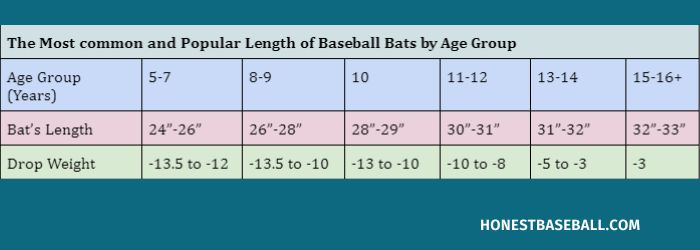
The age group is one of the most impacting attributes in changing the bat size. We can divide the age group into 6 commonly referred groups.
Let’s see what should be the bat’s length, and drop the weight for the players by their ages.
Age Group 5 to 7: The players of age range from 5-year-old to 7-year-old, should swing a bat between 24 inches to 26 inches. In this case, Aa lightweight bat is preferred by most bat size charts for the little players.
So, players in this age group better go for a minimum of -12 to -13.5 bat drop weight. For the younger players, heavier bats are challenging to swing.
Age Group 8 to 9: Some senior players who are aged more than 7, but under 10, I mean 8-year-old to 9 -year-old, should increase their bat length a little. 26 inches to 28 inches would be just perfect bat size charts for them.
Along with this, the bat drop weight should be considered between -10 to -13.5 based on the height of the youngsters.
Age Group 10: The baseball experts say, a 10-year-old youngster can hold 28 inches to 29 inches bat. Their age is reliable to withstand with little bigger bats.
Also, the drop weight should be slightly reduced as well. You may choose from -10 to -13 bat drop weight for a 10-year-old youngster.
Age Group 11-12: Finally, some big bats here. The age group of 11 to 12 years is recommended to use 30 inches 31 inches baseball bats. Aside from this, the drop weight should be increased a little. This age group of youth league players should swing a bat with a drop weight of -8 to -10.
Age Group 13-14: In this age group, baseball players participate both in high school baseball and youth leagues. As they are getting older, using longer bats is recommended. Also, the drop in weight is significantly reduced. As a result, playing with a heavier bat should be accustomed to.
Drop weight – 3 to -5 is recommended for the age group of 13-14.
Age Group 15-16 and Above: Finally, the adult group is here. At this age level, players normally play in collegiate baseball and above. So, the bat length must be increased to 32 to 34 inches or more.
Also, a heavier bat is just as well. You must use a bat with a bat drop weight of -3.
Baseball Bat Sizing Chart: The Perfect Bat Weight
Another essential, but not that important entity in selecting the right bat is the bat’s weight itself. Though we already have shown the bat size by length, and drop weight, now it’s time to determine the perfect of the bat’s weight itself.
Baseball or softball bats’ weight is determined by the ounce. Let’s check the right bat weight by age of players that would be relieving while swinging the bat resting any age group.
Age 7: The perfect weight for the bat would be 14 to 15 ounces if the player weighs under 60 pounds to 70 pounds.
Age 8: There are many recommendations that would be shown for an 8-year-old youngster. The baseball players who are under 60 pounds, up to 70 pounds, a 15-ounce bat is recommended. On the other hand, for a weight 70 to 80 pounds, a bat weight of 16 ounces, for 81 to 120 pounds, a bat weight of 17 ounces is ok.
For the players who are between 101 to 130 pounds, a bat weight of 18 ounces, and for players 131 to 140, a bat weight of 19 ounces would be fine.
Age 9: At the age of 9, the youngster should choose a bat weighing 16 ounces if he is under 80 pounds. 81 to 90 pounded man should go for 17 ounces bat. On the other hand, players weighing 91 to 120 pounds should be ok with the 18 ounces bats.
Players weigh 121 to 150 pounds, a bat is recommended 19 ounces, and a player who weighs 151 to 160 should have a check on a 20-ounce bat.
Age 10: Players weigh under 60 to 70 pounds, bat weight, 17 ounces, player weigh 71 to 100 pounds should go for 18 ounces bats. Also, The players who weigh 101 to 130 pounds, are likely to go for 19 ounces baseball bats. And players who have a weight of 131 to 170 pounds, may check 20/21 ounces bats.
Age 11: With the age of 11, you can choose bats weighing 18 ounces to 23 ounces, based on the weight of your youngsters.
Bat Size Chart for Senior Age Group
Age 12: A baseball bat player at the age of 12 could swing a 19 ounces bat if he weighs from 61 to 80 pounds. But, he should go for a 20-ounce bat if he weighs 81 to 90 pounds. On the other hand, 21 ounces bat is recommended for players who are 91 to 120 pounds.
player weight 121 to 14 pounds, bat weight 22 ounces, player weight 142 to 15 pounds, bat weight 23 ounces, players weight 151 to 160 pounds, bat weight24 ounces, player weight 161 to 170 pounds, bat weight 26 ounces, and player weight 171 to 180, the bat weight should be 27 ounces.
Age 13: At the age of 13, there are several bat weight variations. the batter could go from 20 ounces to 27 ounces based on his weight.
Age 14: The age range 14 is one of the most crucial points for baseball players. At this age, baseball players play in both youth league and high school baseball. So, there is a significant variation in choosing the bat endeavor.
For the USSSA bats and USSSA bats, a 14-year-old youngster could go for different weight distribution. 21 ounces to 27 ounces are the range for him in the youth leagues category.
On the other hand, when the player plays at his high school level, he must play with the BBCOR-certified bats. In this case, the player must start with a 26 ounces bat to participate in high school baseball.
The maximum weight the player can use for the BBCOR bat is 30 ounces in a long run.
Age 15: The players who are in the age of 15, have some variations too. But, the options are reduced as well. A player with the age of 15 can start with a 27 ounces bat. He could also go for a max of 31 to 32 ounces in a long run.
Age 16 and Above: In the last, here is the bat weight for the adult players. at the age of 16 and above, the players get the most reduced and less confusing options. A 28 ounces bat could the initial choice for an adult player.
On the other hand, the batter could use a max weight of 31 to 33 ounces of a baseball bat. As the Batted ball coefficient-BBCOR rules, there is no way to go beyond a 33 ounces bat as the BBCOR rules fixed the highest bat length at 36 inches and drop weight -3.
So, a batter aged 16 or above must not use a bat weighing more than 33 ounces.
Baseball Bat Size Chart by Marucci Sports Goods Company

Marucci is one of the leading baseball bat manufacturers in the baseball industry. Basically, they are at the number 1 position for a long time.
Marucci states, as I have already mentioned before, that there are many variables and entities that impact choosing the right baseball bat size.
Marucci basically prefers the bat size based on the batters’ height. With this entity, there are a lot of hassles that could be skipped, many baseball experts think.
For example, Marucci roughly recommends a bat size chart that shows a player who is 5′ to 5’5″, could go with a bat length of 28 inches to 30 inches.
The players who exceed the height of 5’5″, should prefer bats ranging from 30 inches to 34 inches.
A Specific Study by the University of Arizona for the Right Bat: Weight and Height of the Batter
Arizona University has done a study on the right bat weight based on the batters’ height, and the pitching speed of the ball that the batters face.
By the way, it’s a complicated study that has been done with tons of data. But, here, we are not showing you such complicated data or study processes. Based on the study result, we will just go to show you the mathematical calculation on how to choose the right bat weight for a player, based on the player’s height, and the average pitching speed he faces.
Let’s say, a baseball batter is 70 inches in length. And he faces a 70mph pitching speed on average.
Now, you have to multiply the height of the player by 30.7% of his height and multiply the speed by 12.15% of the speed. After getting the two primary results, add them to each other. the bat length will be shown.
In this case,
the height result= 70x.307= 21.49,
and the speed result= 70x.1215= 8.505.
Finally. the bat weight should be= 21.49+8.505= 29.995 ounces.
So, a player who is 70 inches in height, and faces on average a pitching of 70 mph should use a bat weighing 30 ounces.
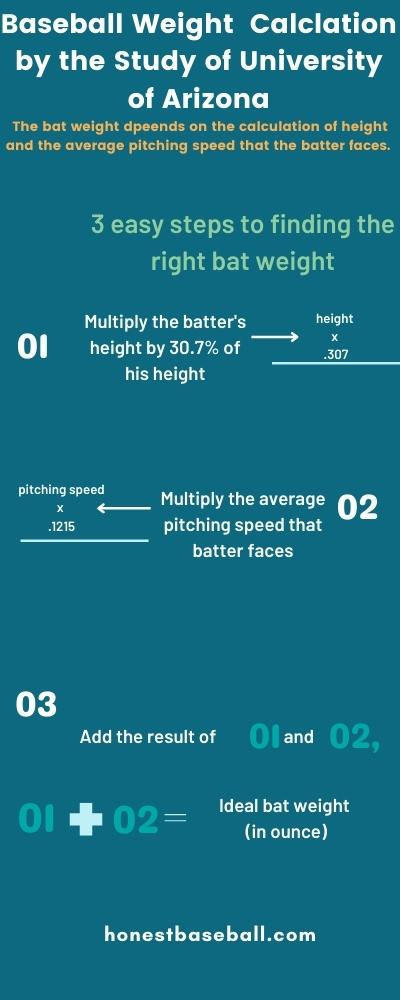
A Survey on Bat Size by Age
Bat Digest is one of the trustworthy baseball expert sites that gathered data on baseball bats based on several factors. They conducted the survey on a wide range and got responses from 2700 responders.
Let’s see some highlighted results they got from the survey.
- In choosing the best-sized bat, the weight and height of the players are not those bigger facts to impact. Rather, the age of players is the most indicative entity in choosing the right-sized bat for comfort.
- The dramatic fact is, that taller players anyhow prefer short-size bats. A taller player doesn’t prefer a heavy bat.
- Among the 2700 responders, the data say the weight of the players is not determining the size of the bat.
- The preferred size for the 8-year-old batters seems too heavy for them, the survey says so.
- Players 13 years old from the youth league think their bats are lighter than expected.
Bat Size Charts on Popularity by Age: Bat Digest Survey Result
Finally, we are going to show you some data about the popular bats along with bat drop by age. Let’s check them visually by the graphical presentation. All surveys are taken place among 100 users for each age range.
Baseball Bat Size Popularity by 7-Year-Old
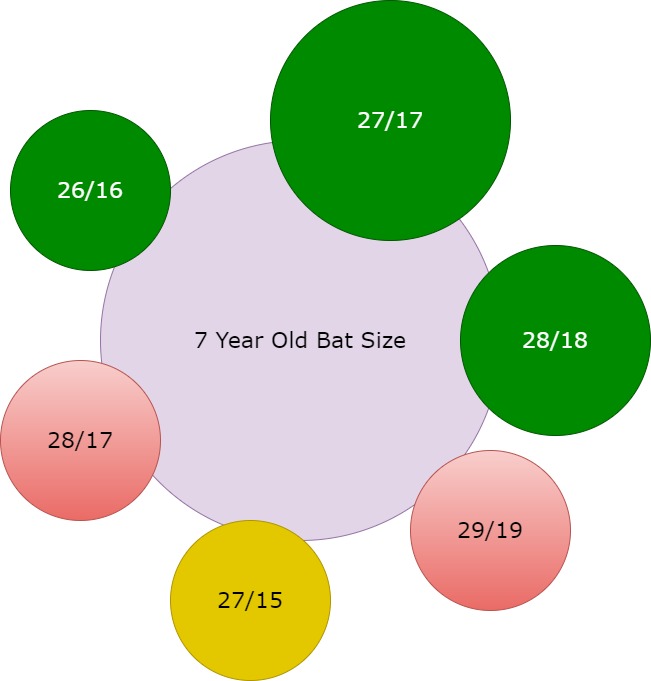
To the survey result, the most popular bat for 7-year-old players is 27/17. That shows that 27 inches bat with a bat weight of 17 ounces is the most popular one among the 100 players. In this case, the drop weight goes -10.
By the way, also 28/18 and 26/16 are just fine as well. But the 29/19 and 28/17 are a little too heavy for the age of 7. Whereas, the 27/15 is on the other hand lighter one.
So the bat popularity is as follows for the 7-year-old youngsters:
- 27/17.
- 28/18.
- 26/16.
- 28/17.
Baseball Bat Size Popularity by 8-Year-Old
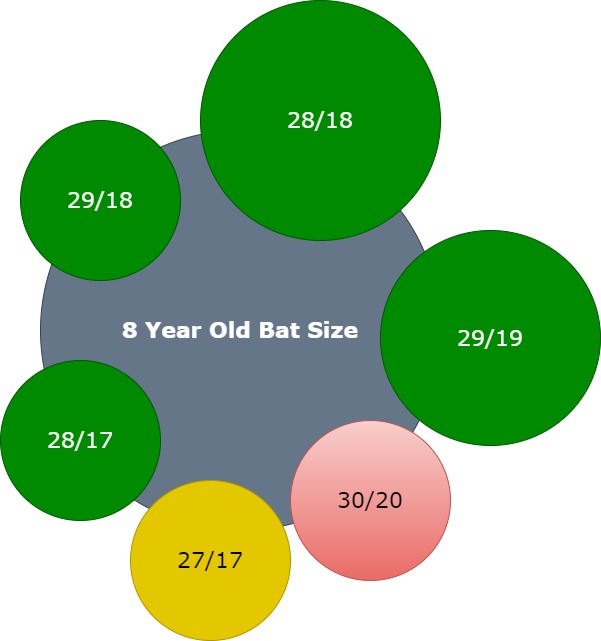
The most popular bat size among 8-year-old youngsters is 28 inches bats along with a bat weight of 18 ounces. Along with this, 29/19 is the second most popular one. On the other hand, 29/18 and 28/17 are also just fine.
But, 30/20 is a little heavier, whereas 27/17 is a little lighter for them.
By the way, parents who think their kids are short, prefer 18 ounces bats. Rather they prefer 17 ounces or 19 ounces(don’t know why 19). But, Tall players are preferred to use 18 ounces bats.
By the way, as there are a bunch of options available for the 8-year-old players, the safest one would be the 28/18, the survey shows.
So the popularity line shows the following options at all.
- 28/18.
- 29/19.
- 29/18.
- 28/17.
The following guide on “Best Baseball Bat For 7-8 Year Old In 2022” could be relieving for you to pick the best bat from hundreds of options.
Baseball Bat Size Popularity by 9-Year-Old
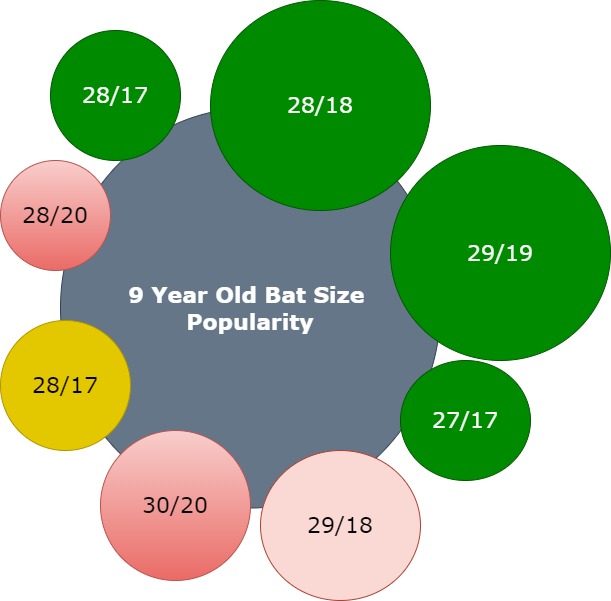
The most popular bat size for the 9-year-old fellows is 29/19, and 28/18. Both indicate a drop weight of -10. the usage of 29 inches and 28 inches bats holds more than 80% of use along with -10 to -11 drop weight.
Because, 28/17, and 27/17 are also popular among youngsters aged under 9.
Aside from these, some of the players with the age range of under 9 also swing 30/20 and 28/20 bats. But they are too heavy in a long run the survey shows.
On the other hand, 29/18 bats have also used the batters in this age range which seems a little heavy bat. But, the 29/17 option is lighter for the batters who use this size.
The optimal choice list, as a result, is
- 28/18.
- 29/19.
- 30/20.
- 29/18.
- 28/17.
- 27/17.
- 29/17.
- 28/20.
Baseball Bat Size Popularity by 10-Year-Old
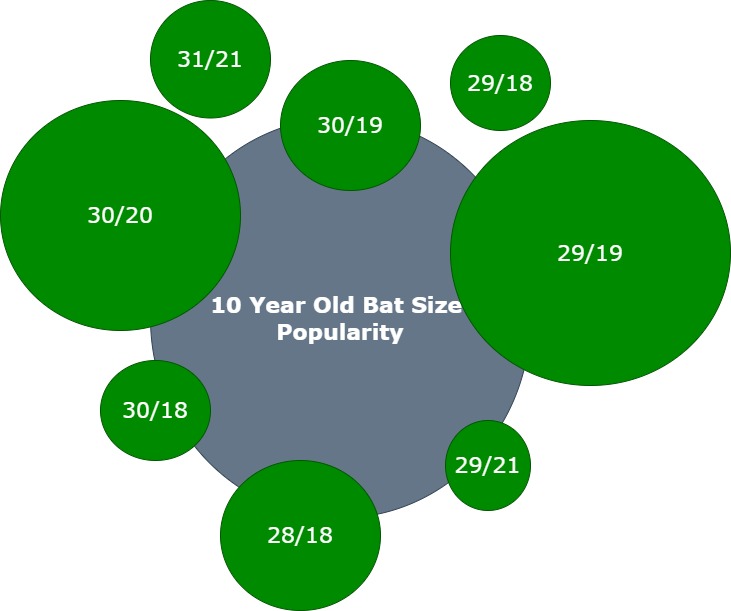
The most popular bat size among the age of 10 is 29/19 and 30/20, where the drop weight is 10. This range makes a 90% usage among the 10 years old youngsters.
By the way, if I am asked the exact one, the 29/19 would be the safest one based on several criteria. However,
Another fun fact for this age range is, that there is no heavier, or lighter bat weight among the recommended length and weight range. For example, 10-year-old players also swing on 28/18, 30/19, 31/21, 30/18, 29/18, and 29/21, all are swung by this age range.
That shows, that the drop weight ranging from -8 to -12 all are ok in swinging.
So, the popularity serial of the bat sizes by 10-year-old youngsters are
- 29/19.
- 30/20.
- 28/18.
- 30/19.
- 31/21.
- 30/18.
- 29/18.
- 29/21.
By the way, if you are looking for the best baseball bats for your 10-year-old kids, you may check on our guide on “8 Best Baseball Bats For 10 Year Old In 2022” for the best pick and explanation.
Baseball Bat Size Popularity by 11-Year-Old

The most perfect bat length for an 11-year-old is a 30-inch bat along with 20 ounces of weight. Aside from this, the weight range of the bat varies from 19 ounces to 21 ounces.
But, more than 40% of bats are used with the 30-inch length, which weighs from 19 to 21 ounces.
On the other hand, another total of 40% of players uses 29 and 31 inches baseball bats within the same total weight categories.
By the way, more than 200 parents answered the questions about the bat size of their particular 11-year-old baseball players.
The most significant fact about the 11-year-old fellows is, that there is no such recommended bat length that is uncomfortable at all. Though the popularity of the bat sizes and weight combinations vary, bat sizes from 29 inches to 31 inches, are just fine with weights ranging from 19 ounces to 26 ounces.
The ultimate popular list for 11-year-old baseball players is
- 30/20.
- 31/21.
- 29/19.
- 30/22
- 31/23.
- 29/21.
- 31/26.
- 30/19.
- 32/22.
Baseball Bat Size Popularity by 12-Year-Old
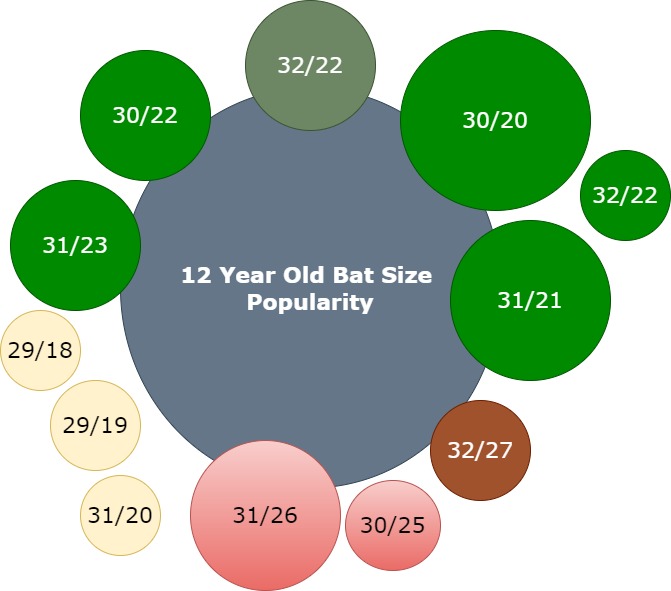
There are a lot of options for 12-year-old guys. Because there is no particular right bat size that could dominate the popularity all along in this age group.
By the way, 30/20 seems the most popular one. Also, drop weight 10 is on the other hand the most popular drop weight among the bat length. Even, drop weight 8 is the second most popular length to weight ratio for the age range 12.
But, in the end, some may find a drop weight of -5 alluring to swing as well as with more weight. But, this seems a little heavy on the other hand. So, basically, taller players are recommended to swing a little heavier bats.
As you see, the age range of 12 years is tried to test all recommended bat lengths along with all possible drop weights they should swing with.
On the other hand, as the bat weight ranges of 20, 21, 22, 23, and 24 ounces are all ok, 25, and 26 ounces are a little heavier. But, the 27 ounces bat with a bat length of 32 inches is the heaviest bat for the age 12.
The most popular lineup for 12-year-old is:
- 30/20.
- 31/21.
- 30/22.
- 32/22
- 31/23.
- 31/26.
Baseball Bat Size Popularity by 13-Year-Old: Non-BBCOR

Ok, there are things to clarify first. 13-year-old players play both youth leagues (dixie youth baseball, Babe Ruth, Pony League, Major Division, etc.) and high school baseball where the BBCOR bats are a must.
So, the bat choice for the two leagues will be different expectedly.
By the way, you may already have seen that the drop weights -5, -8, and -10 are the options they swung in the survey of 100 players. Among them, the most popular bat size is a 31-inch bat length along with a drop weight of 5 and a bat weight of 26 ounces.
The second most popular option is 32 inches bats along with a bat weight of 22 ounces and drop weight of -10.
But they are quite ok with the bat length of 30 inches and 31 inches drop weight range from -5 to -8.
Most of the non-BBCOR 13-year-old buddies think their bats are more lightweight than they expect. among the length-to-weight ratio of -10, -8, and -5, -5 allows the development of their muscles for the next level of BBCOR baseball.
Baseball Bat Size Popularity by 13-Year-Old: BBCOR
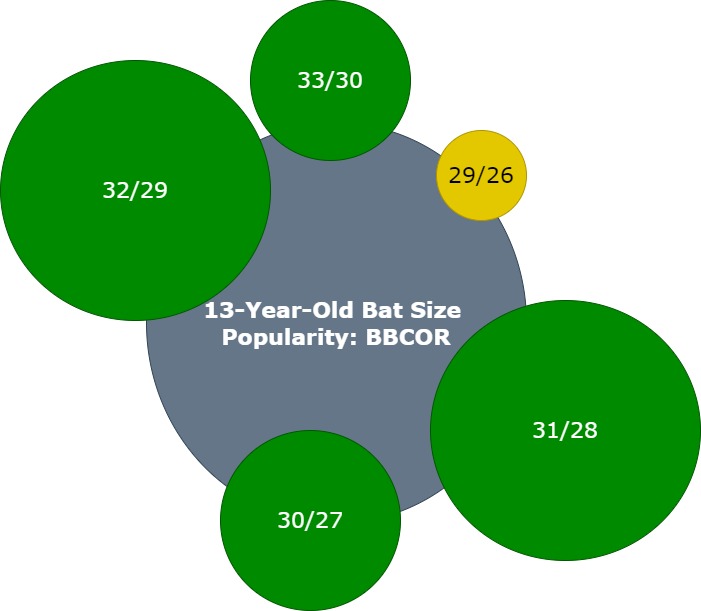
BBCOR is the easiest age group and league to pick the right bat. Because the bat options are dramatically reduced for the BBCOR league that is governed by NFHS and NCAA.
High school baseball allows only the BBCOR-certified bats that require a drop weight of -3. It is a must for playing in high school baseball.
Also, the bat length is fixed among the 29, 30, 31, 32, 32.5, 33, 33.5, and 34. Though up to 36 inches bats are also allowed, most players go up to 34.
However, the most popular options are 31 inches and 32 inches among the 13-year-old BBCOR baseball players. Aside from these two options, 30 inches bats are the second most popular, and the 33 inches are so. But, they are only among the popular 10%.
31 and 32 inches hold more than 90% of popularity among the 13 -year-old BBCOr players.
But, 29 inches bat size with 26 ounces is a little lighter for the age range.
So the popular lineup is as follows.
- 31/28, or 33/29.
- 30/27.
- 33/30.
- 29/26.
Baseball Bat Size Popularity by 14-Year-Old: BBCOR
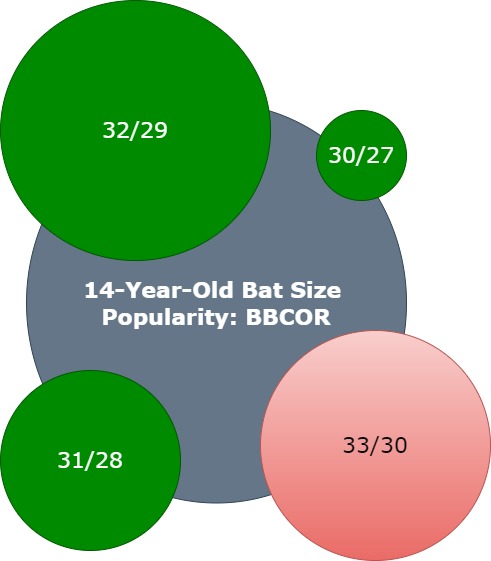
The 14-year-old buddies are all going for 32 inches, 33 inches, and 31 inches baseball bats simultaneously. Though the most popular one is 32 inches, 33 and 31 hold the next positions respectively.
But, 33 inches along with 30 ounces weight seems a little heavier at this stage for the 14-year mates.
Summing up all things, we would suggest you for the 32/29 bats that are picked the most responders.
Though 34 could’ve great option too, the survey didn’t show any of the responders willing to pick a 34-inch bat at all.
so, the lineup goes like this:
- 32/29.
- 33/30.
- 31/28.
- 30/27.
Baseball Bat Size Popularity by 15-Year-Old: BBCOR
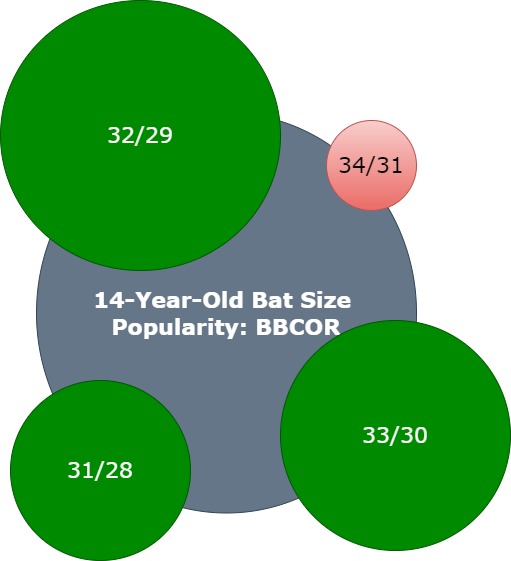
You see in the diagram that the 32 inches BBCOR bats hold the most popular place for the age of 15 years old baseball players as the right size bat. As the BBCOR regulations force them to pick the -3 drop weight, most players choose 32 inches bats at this age.
But, the number of picking the 33 inches bats is undeniable as well. The fact is, the taller players love to swing less swing weight, which is an unsolved mystery in a long run.
Most of the better players (who seem like that) prefer the 32 inches bats over the 33 inches ones. By the way, there is a smart number of 31 inches bats are also picked. But, 34 inches seems a little too heavier bat size for 15-year-old BBCOR baseball players.
Baseball Bat Size Popularity by 16-Year-Old: BBCOR

With rising the age range, the options for choosing bats decrease, and the confusion so. Most portion of 16-year-old players is most likely to pick the 33 inches baseball bats. The second most pick is the 32 inches bats over the 34 inches ones.
As we mentioned before more than one time, the shorter players like to pick heavier bats, whereas the taller players do the opposite.
By the way, there are also some responders who like to swing 34 inches bat. And as a result, they are not heavier bats for them as well. Though the number of players who swing 34 inches bats is a little, they are happy when swinging them.
By the way, after summing up things, the 16 years could go for the following popular lineup.
- 33/30.
- 32/29.
- 34/31.
Baseball Bat Size Popularity by 17-Year-Old and Above: BBCOR
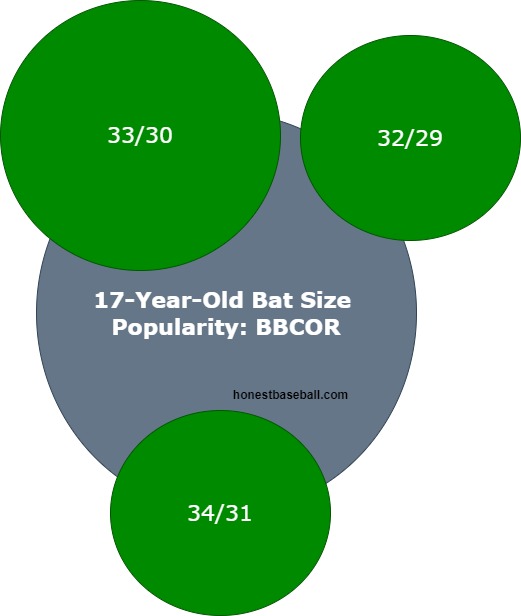
The 17-year-old category got a huge survey among thousands of BBCOR baseball players. And the fact is, most of the players consider them shorter than the typical tall length at this age.
As a result, you will see, that the use of the bat length of 34 inches increased here than in the 16- year-old category. Though the most popular pick is 33 inches bat for the 17-year-old BBCOR baseball players, 32 inches and 34 inches have simultaneous usage as well.
The proportion is 50% for 33 inches bats, whereas the other 50% is for the 32 inches and 34 inches bats combined.
The following is the popular lineup for 17-year-old players in order.
- 33/30.
- 32/29.
- 34/31.
By the way, as you see, there are a lot of things to consider while choosing the right size bat. After measuring the right size, you may have another confusion about which BBCOR would the best.
Seems confusing again? You may check on our "20 Best BBCOR Bats That Are Ready To Dominate The Plate In 2022" to select the best BBCOr baseball bat suggested by experts.
Softball Bat Size Chart: Choose the Right Size Softball Bat
Aside from the baseball bat, the softball bat also needs to be picked the right size by age. If you are going to pick a softball bat for your 7-year-old kid, you should go for 24 inches to 26 inches bats.
But when the age ranges from 8 to 9, a bat length of 26 inches to 29 inches is preferable. For the age ranges from 10 years to 11 years, a softball bat ranges from 28 inches to 30 inches would be a perfect bat.
On the other hand, players aged between 12 to 13 years old should use bats lengthened from 29 inches to 33 inches.
But when your kids or you exceed the age range of 14, the bat length also should be reached 31 to 34 inches.
I call you for easiness, you will see a little difference in picking the size of a baseball bat and softball bat in length.
What Are the Types of Baseball Bats & Materials?
Baseball bats are generally made of 4 types of materials. Wood, aluminum alloy, composite material, and hybrid (wood, alloy, composite, all could be used combinedly).
Wood Bats
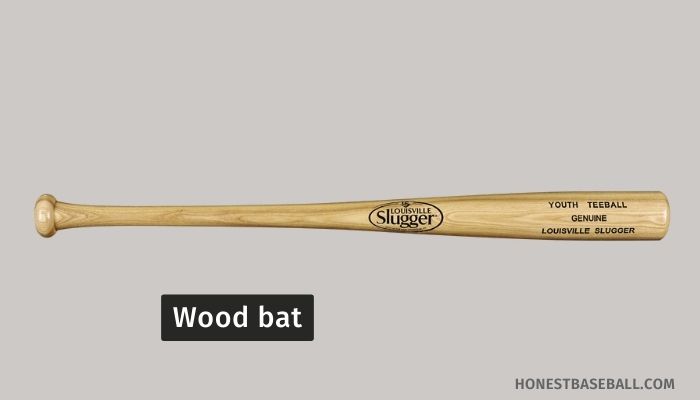
Wood bats are made of pure hardwood which is only allowed bat in the Major League baseball-MLB. Ash, maple, hickory, and bamboo are used to make wooden bats. Among them maple gets is the most popular in making wooden bats over the last 20 years.
75 to 80% of MLB bats are made of maple wood by this time.
On the other hand, hickory wood is used less for its heavy weight. Ash is the second most popular wood bat. As the MLB only allows wooden bats, MLB players cannot use other materials bats.
However, a wooden baseball bat is ready for the game out of the box.
By the way, a wooden baseball bat gives the following advantages to a batter.
- A wooden baseball bat gives great balance.
- You can utilize your own muscle power instead of depending on the bat. No artificial or machine power.
- A wooden baseball bat gives better feedback to learn the exact sweet spot and hitting area.
- Helps to develop self-pitch discipline.
Aluminum Bats
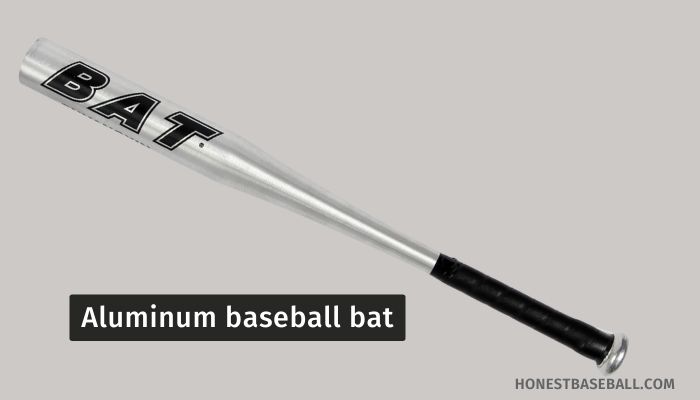
Aside from the wooden bats, metal bats are used in the amateur leagues like little league baseball, high school, and collegiate baseball league. Among these, the metal bats must be batted ball coefficient of restitution in high school and collegiate baseball.
By the way, aluminum bats are made of high-grade aluminum alloy. They are hot out of the wrapper. That means you can use the bat out of the box instantly in the games.
Alloy bats tend is started back in the 1970s when the Worth company first brought them on the market. The aluminum bats are first introduced to college baseball in 1974.
The aluminum bats feature the following advantages in using them.
- An alloy bat is stronger and more durable than a wooden bat.
- Alloy bats are game-ready out of the box. No break-in time is required.
- Comparatively, aluminum bats are more cost-effective than wooden bats, since aluminum bats are more expensive. Because, wooden bats get cracked easily, whereas, alloy bats have a longer lifespan, and no need to replace often.
- Provide larger sweet spots.
- Most leagues allow aluminum bats.
Composite Bats
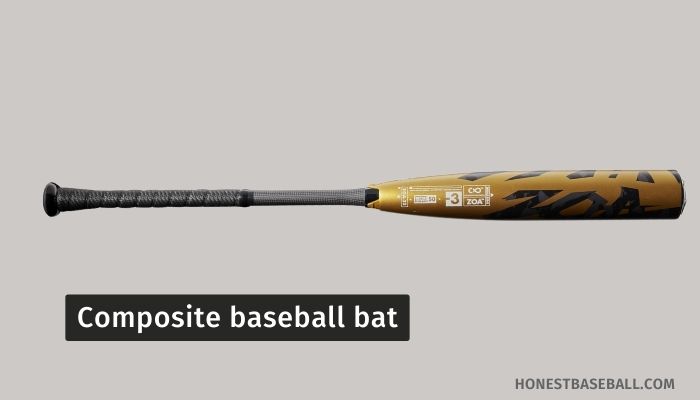
Composite bats are made of materials that is opposing aluminum and wood. A material like carbon fiber is a reinforced polymer for making composite bats. Composite materials, on the other hand, give the ultimate advantage to doing the weight distributed properly across the bats.
Also, the baseball bat manufacturers get ultimate control over the bat gives them to ensure the required weight distribution, which could be balanced or end-loaded.
The composite bat has a significant feature. Manufacturers can ensure larger sweet spots for composite bats. As we discussed the aluminum bat before, composite bats give more durability than aluminum baseball bats.
But, on the other hand, bats are made of composite materials (reinforced polymer) that need a longer break-in period than aluminum bats.
By the way, composite bats are tensed to improve the trampoline effect over time. Though, the trampoline effect is governed by the NCAA, NFHS, and USSSA authorities.
However, don’t use composite bats under 60° F. This could be cracked if you do so.
Composite bats give a lot of advantages in their own way. Let’s see what will you get from the composite bats.
- Composite bats are designed in such a way that allows controlling the swing weight. Swing weight gives the feel of the heaviness of the bat while swinging. In the composite bats, swing weight distribution has more control than the aluminum bats.
- The trampoline effect is the phenomenon of when baseball comes out off the bat while contacting. This increases the exit velocity of the ball. The more trampoline effect, the harder hitting. Composite bats outperform all-aluminum bats in terms of the trampoline effect by keeping the value under the predetermined range.
- Composite bats are improved in the vibration sector. They ensure less vibration than wood and aluminum bats.
Hybrid Bats
The name refers to the objective of the bat. Hybrid bats are made of a combination of different materials combined. Composite, aluminum, and wood, all could be used combined for making hybrid bats.
But, in most cases, alloy barrels and composite handles are combined hybrid bats. So, this ensures durability and lighter swing weight.
Hybrid bats feature some astonishing advantages in the long run.
- Hybrid bats are more cost-effective than composite bats but provide the feature of composite bats.
- Give lighter swing weight than aluminum bats.
- As the barrel of hybrid bats is mostly made of aluminum, they are ready to play out of the box.
- Also, hybrid bats are significantly durable.
But at the end of the day, all leagues do not allow hybrid bats to swing in them.
Baseball Bat Facts
There are things to be clarified more before buying baseball bats. Bat length, drop weight, and swing weight is some important terms by the way.
Bat Length
Bat length is an easy term to understand. It is the determination of the whole length of a baseball bat. The length is measured in inches from its knob to the end.
A longer bat size helps you to reach more distance. As a result, you are able to hit the balls and even outside of the plate. But, longer bats do not mean the best option for always.
You should always measure the perfect bat length with efficient methods. A dedicated section you will find later on this post on how you can determine the perfect length for your bat choice.
By the way, most of the bat lengths range from 24 inches to 34 inches based on the age of the players. But, you will also see some 36 inches bats as well.
Drop Weight
Now, let’s talk about one of the most used terms in baseball. I have mentioned the term drop weight a lot of times in this post already. So, what do understand about this term? Actually, how is it important so I needed to mention this at such a time?
Let’s find out the facts about the drop weight or bat drop.
Drop Weight is another name for the ratio of length to weight. The discrepancy between the bat’s length and weight is what causes the issue. Inches are used to measure length, whereas ounces are used to measure weight.
For example, is a bat lengthened 34 inches, and the drop weight is -5, which means, the weight of the bat is 29 inches. Oh! the drop weight is mentioned with a minus sign before the number.
The more the drop weight, the lighter the bat is. Less drop weight means heavier bats. So, a bat with a -3 drop weight must be heavier than a bat with a drop weight of -10.
Youth league baseball players basically use lighter baseball bats that could be weighted -5, -8, -10, -12, -13, and -13.5.
However, there are some precise entities that impact choosing the drop weight of the bat. They include the rules of the league, preferences of the players, and the governing body you are playing under.
Basically, all American baseball leagues are governed by the following three governing bodies: USA baseball, USSSA baseball, and BBCOR.
But, professional baseball leagues like MLB required a -3 drop weight. Also, high school baseball and collegiate baseball’s prerequisite is a -3 drop weight for baseball bats that are governed by BBCOR.
And, youth leagues are governed by USA Baseball and USSSA baseball which allows lighter bats with more drop weight than -3.
Swing Weight
In the simplest state, the swing weight of the at refers to the power that it takes to swing the bat. That means you will feel the swing weight while swinging the bat.
Basically, a pivot point along with the mass moment of the inertia is considered to determine the swing weight of the baseball. Also, you can say, wing weight is the state of how particular the actual weight of the bat is distributed across the entire bat.
For example, you may have two bats that are 32/29. But you see, this bat will not feel the same even having the same total weight. As the weight distribution could be different for each other.
Here the term,s balance weight, and end-loaded come. For the balanced weight bat, you will feel the evenly balanced weight for the entire bat. On the other hand, the end-loaded bats have more weight implemented on the end of the bat.
The same weight, but distributed differently brings different swing weights for the same weight.
How to Measure the Perfect Bat Length
There are things to consider out of the box too. You can skip the theoretical things when you have natural options to select.
Aside from picking the right bat size by age, there are ways that you can pick the right bat length naturally in your comfort zone.
By the way, bat length is important to give success on the plate. You shouldn’t pick the too long that would be rough to control by you. Also, you shouldn’t pick too short which will decrease your plate coverage.
Let’s check the way you can pick the right bat length as your own.
- Simply take a baseball bat and position the knob side in the center of your chest if you’re at a baseball bat store. Propagate the bat’s end to your side now (Never bother with the left or right side, choose whatever you want).
Now it’s a typical size for you if your fingertip fits comfortably at the end of the bat. - Place the bat’s knob on your chest. facing forward, stance. Spreading the bat now, attempt to go to the barrel’s middle. Take the shot if you can steadily grasp the bat’s barrel.
- The last but not least, the option is to measure the standing size of the bat. Just keep the bat on the ground with its end. Put your hand straightly on the knob and grab it. See, can you comfortably reach the knob? Does the knob reach your palm?
If so, you can take the bat.
Baseball Bats Governing Body and Rules
BBCOR Bats
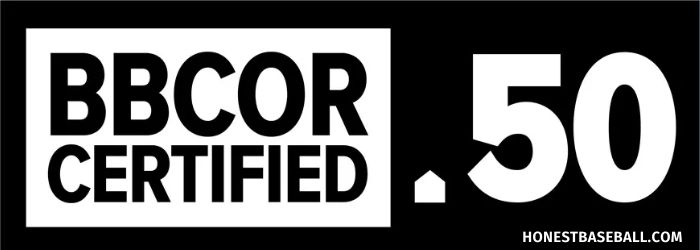
BBCOR is the standard for governing adult baseball: high school and collegiate baseball. BBCOR set the rules for bats that are mandatory to meet the standard for high school and college baseball.
The BBCOR stands for Batted Ball Coefficient of Restitution. National Collegiate Athletic Association (NCAA) and the National Federation of State High School Associations (NFHS) are two governing bodies that control the BBCOR rules and regulations.
By the way, the main perspective of BBCOR regulation is to bring the metal bat’s performance near to wood bats. And this happens to keep lowering the trampoline effect under 0.50.
If you look for BBCOR bats, the bat must have a BBCOR .50 stamp on it. Otherwise, the bat will not meet the standard. Also, the drop weight of the BBCOR bats is -3. It is a must, not more, not less.
And, the barrel size diameter of the BBCOR bat cannot exceed 2 5/8 inches.
So, if you sum up the rules, they will look as follows.
- Drop weight is -3.
- The barrel diameter of the BBCOR bat must stay under 2 5/8 inches.
- The trampoline effect must be under .50.
- The max length of a BBCOR bat could be 36 inches.
USA Baseball Bats
USA baseball governs the little league baseball in America. The rules and regulations of the USA baseball bat are almost identical to the BBCOR rules.
But, there is a core difference between this two. The difference is their dropped weight. Where BBCOR is fixed with the bat drop weight of -3, the USA bats have broad acceptability here.
There is no restriction on the drop weight of the bat by the USA regulatory authority. As the little leagues are governed by the USA, and the players all are underaged, the bat weight should be lighter here.
And you know, the more the drop weight, the lighter the bat is.
The lightweight bats give youth players the to swing their bats fast. That helps to develop their ability to hit, and hitting style.
By January 1, 2018, USABats adopt new standards, which made all older bats before 2018 illegal. If you want to join the USA leagues like Dixie youth baseball, Cal Ripken, Babe Ruth, etc., you must use USA standard bats, or at least BBCOR certified bats.
USSSA Bats
USSSA stands for the United States Specialty Sports Association. It is a non-profit sports organization that governs different types of sports in the USSA.
In baseball, USSSA bats are used in youth leagues between the age of 5 to 14. There is ample reliability in the USSSA bats rules. Unlike BBCOR regulations, USSSA allows more trampoline effects which are up to 1.15 BPF (Bat Performance Factor).
So, if you look for a new bat for youth leagues with more trampoline effect and larger barrel size, USSSA bats are for you.
By the way, USSSA bats are made by only USSSA-approved baseball manufacturer companies like Wilson Baseball Equipment Manufacturer, Rawlings Sports Goods Company, Easton Goods Company, Marucci Sports Company, etc.
The USSSA bats must meet the following standards.
- BPF up to 1.15.
- Barrel size is up to 2 3/4 inches.
- The minimum bat length is 29 inches.
- Allowed drop weights are -5, -8, and -10.
How to Choose the Best Quality Bat for You?
After a long journey, now we may know what is the perfect size bat for a baseball player. I don’t think that you will be confused further after entirely adopting the chat we have provided based on several types of surveys and studies.
But, it’s important to pick the best baseball bats when it comes to quality. Quality and sizing are not the same facts. So, if you pick a poor bat with the right size, it will not serve you a lot.
Just make sure you combine the right size along with the best quality with your determined budget.
So, how come you be assured of the quality of a great bat? Let’s find out the ways.
Materials and Durability
The most essential fact to consider is the materials of the baseball bats. Materials are catalyzers for keeping the bats durable. Also, the materials determine the price of the bats as well.
There are mainly two types of materials used for making baseball bats: wood and metal.
Wood bats are less-prices. Different woods, such as maple, ash, or birch are used for bat making. Wood bats are fundamentally BBCOR approved along with -3 drop weight.
Aside from the wood bats, alloy and composite materials are used to make metal bats. Metal bats are costlier than wood bats.
On the other hand, alloy bats are hot out of the wrapper. This means alloy bats don’t need break-in time. Though composite bats need a particular break-in time, they are more durable than alloy bats.
One-Piece Bats and Two-Piece Bats
It is another important point to consider that either a one-piece bat or a two-piece bat will take. There is a fundamental difference between the one-piece bats and the two-piece bats. This is the flex and energy transfer fact.
Basically, wood bats are one-piece. One-piece means the continuous made of the bat without any joints. One-piece bats are stiffer, generating more power.
On the other hand, two-piece bats mean two separate pieces of bats joined together. They are made with the fusion of a separate handle and barrel. As a result, the two-piece bats give more flex and faster bat speed.
Also, the two-piece bats are designed to reduce vibration and stings. It’s upon you which one suits you most. If you are a power hitter, one-piece could be your choice. But, if you are got to go with two-piece bats with more flex.
Frequently Asked Questions
Is bat Rolling Illegal?
Fundamentally, bat rolling is not illegal. But, if it changes the shape and performance of the bats, it’s no more legal to use bats. So, make sure, your bat rolling machine doesn’t violate the rules and changes the shape of the bats.
Find out more on Illegal Baseball Bats – Models and Methods.
Wrapping up
A proper bat size chart is likely to help you to pick the right-sized bat for swing. Before picking the bat for the next little league baseball league or adult baseball, it’s essential to do a precise study.
Aside from the theoretical studies, a physical try will be more effective to pick the right-sized bat fast. But, be sure, a precise theoretical study will help you to determine the range of the bat size, and give you more options.

Hello everyone. My name is Jason Butler, and I live in California, America. I was a professional AAA Minor League Baseball player. I lost my chance of playing MLB for injury issues, but I did not lose my love for baseball. I attended the coaching training program and am now working as a coach in a small school in San Diego.
I always love to share my experience and knowledge if that can help you. Play baseball, and stay fit.
